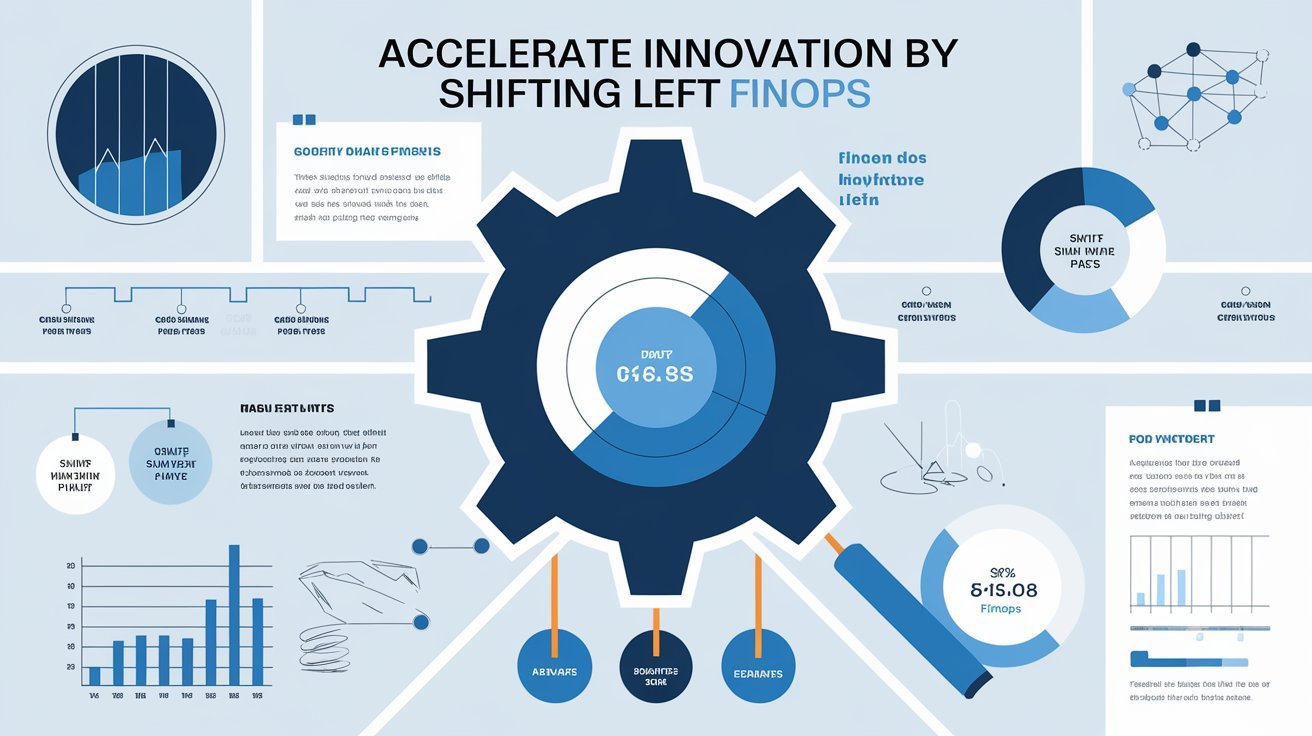Introduction to Shifting Left Finops
In today’s fast-paced business landscape, the ability to innovate rapidly is more critical than ever. Companies that can adapt and evolve not only survive but thrive. Enter FinOps, a game-changing approach that aligns finance with operational needs, ensuring an agile response to market demands. But what happens when we take this concept a step further? By shifting left in the FinOps process, organizations can create a seamless integration between finance and development teams right from the start. This strategy empowers businesses to accelerate innovation effectively while maintaining cost efficiency.
This sixth installment of our series accelerates innovation by shifting leftFinopss: part 6 delves into how adopting a shift-left mindset in FinOps can unlock new levels of creativity and speed for your organization. Let’s explore why embracing this innovative approach could be the key to staying ahead in today’s competitive environment.
accelerate innovation by shifting left finos part 6
Shifting left in FinOps represents accelerated innovation by shifting left finops: part 6is a paradigm shift, focusing on integrating financial operations earlier within the development lifecycle. This approach enhances collaboration between finance and technology teams, creating a more cohesive strategy for managing costs.
By embedding financial considerations from the outset, businesses can proactively identify potential budget overruns. This foresight allows them to make informed decisions throughout their project lifecycles.
Automating expense tracking further streamlines this process. It minimizes manual errors while providing real-time insights into spending patterns. With accurate data at their fingertips, leaders can pivot quickly when necessary.
Real-life examples highlight how to accelerate innovation by shifting left finos: part 6 companies have leveraged these practices to stay competitive. They’ve seen faster deployment times and improved resource allocation as a direct result of adopting shifting left strategies in FinOps.
This transformation is crucial as organizations strive to maintain relevance in an ever-evolving market landscape where agility and efficiency are paramount.
The Importance of Accelerating Innovation
Innovation is the lifeblood of any thriving business. In today’s fast-paced market, companies must continuously evolve to stay competitive. Accelerating innovation fosters agility and responsiveness to changing consumer demands.
When organizations prioritize innovation, they unlock new revenue streams and enhance customer experiences. This proactive approach leads to sustainable growth and long-term success.
Additionally, faster innovation cycles equip businesses with the tools necessary for quick adaptation in a rapidly shifting landscape. Companies that embrace this mindset are better positioned to leverage emerging technologies and trends effectively.
Moreover, accelerating innovation cultivates a culture of creativity among teams. Encouraging experimentation can lead to unexpected breakthroughs that propel an organization forward.
Embracing a proactive stance on innovation not only boosts profitability but also strengthens brand loyalty. Engaged customers appreciate brands willing to innovate relentlessly in pursuit of excellence.
Understanding the Concept of
Understanding the concept of shifting left FinOps begins with a mindset change. It emphasizes integrating financial operations into every stage of the development lifecycle.
Traditionally, finance teams have operated in silos. They would often review budgets and expenses after projects were underway. This approach can lead to overspending and misalignment with business goals.
By shifting left, organizations accelerate innovation by shifting left ffinos part 6 enencouragesollaboration between developers and finance early on. This partnership fosters transparency around costs from the initial planning phases.
Moreover, it empowers teams to make informed decisions based on real-time financial data. When everyone has access to cost insights, innovation flourishes without fear of budget overruns.
This proactive strategy not only enhances efficiency but also accelerates time-to-market for new products or features. Embracing this holistic view transforms how businesses approach financial management within their tech environment.
How Shifting Left Finops Can Benefit Businesses
Shifting Left FinOps offers a transformative approach for businesses seeking to enhance their financial operations. By integrating financial accountability earlier in the development process, teams can make informed decisions that directly impact budget management.
This proactive stance fosters accelerated innovation by shifting left finos: part 6 collaboration between finance and operations. With shared goals, both sides work towards optimizing resources and reducing overspending.
Increased visibility into costs allows organizations to track spending in real-time. This transparency uncovers insights that drive innovation while minimizing waste.
Moreover, automated tracking tools further streamline processes. They reduce manual errors and free up valuable time for teams to focus on strategic initiatives rather than administrative tasks.
The culture of continuous improvement emerges as stakeholders adapt quickly to changing market demands. Embracing this shift not only enhances operational efficiency but also propels growth through agile decision-making.
Steps for Implementing Shifting Left Finops
Implementing Shifting Left FinOps requires a strategic approach. Start by fostering collaboration between finance and development teams. Regular communication ensures that both parties are aligned on goals and expectations.
Next, focus on automating processes. Utilize tools that track expenses in real time, providing visibility into financial data as it relates to project progress. This reduces manual errors and enhances efficiency.
Incorporate continuous feedback loops throughout the innovation process. Encourage teams to review financial implications at each stage of development rather than waiting until the end.
Training sessions can also be beneficial. Equip your teams with knowledge about FinOps principles so they understand their roles within this framework.
Establish clear metrics for success. These should reflect both financial performance and innovation outcomes, guiding future efforts effectively while maintaining accountability across departments.
Real-Life Examples of Successful Implementation
One notable example of accelerated innovation by shifting left finops: part 6 successful implementation is a leading e-commerce platform. By shifting left in their FinOps approach, they integrated finance into the early stages of product development. This collaboration allowed teams to identify cost implications upfront, optimizing budget allocation and reducing unnecessary spending.
Another case involves a prominent SaaS company that automated its financial operations. By leveraging tools for real-time tracking and reporting, they empowered developers with insights into costs associated with cloud services from day one. This transparency led to more informed decisions regarding resource utilization.
A major automotive manufacturer also embraced this strategy. They established cross-functional teams where finance specialists worked alongside engineers during design phases. As a result, they streamlined processes and substantially decreased time-to-market for new models while maintaining strict budget controls.
These examples illustrate how diverse industries can harness the benefits of shifting left in their FinOps practices, driving innovation forward effectively.
Challenges and Solutions for Adopting Shifting Left Finops

Adopting Shifting Left FinOps comes with its set of challenges. One primary hurdle is the resistance to change within teams. Employees may be comfortable with traditional processes and hesitant to embrace new practices.
Another challenge lies in the integration of finance tools into existing workflows. Many organizations operate on legacy systems, which can complicate data sharing and real-time tracking.
To address these obstacles, fostering a culture of collaboration is vital. Encouraging open communication between finance and development teams creates a unified approach toward innovation.
Investing in training ensures that all team members understand their roles within this framework. This educational push can alleviate fears associated with transitioning to Shifting Left FinOps.
Leveraging automation tools alsostreamlines financial operations, reducing manual errors while enhancing efficiency. These solutions pave the way for smoother implementation and greater acceptance across departments.
Conclusion: Embracing Shifting Left Finops for Future Success
Embracing Shifting Left FinOps positions businesses to thrive in a fast-paced digital landscape. By integrating finance into the early stages of development, organizations can streamline processes and enhance collaboration.
This approach accelerates innovation by shifting left finops: part 6 cultivates an environment of proactive decision-making. Teams are empowered with real-time insights into costs, fostering better financial accountability.
Moreover, automation reduces manual errors and accelerates tracking expenses. As companies adopt this mindset, they unlock innovation potential that drives growth.
The future belongs to those who adapt quickly and efficiently. With Shifting Left FinOps, businesses not only safeguard resources but also create opportunities for creative solutions and technological advancements.
Investing in this strategy is more than just a trend; it’s a necessary evolution for sustainable success in today’s competitive market. The journey toward transformative practices starts here—where finance meets agility for remarkable outcomes.
Introduction to Shifting Left Finops
Shifting Left FinOps is a transformative approach that integrates financial operations early in the development lifecycle. Traditionally, finance teams often engage after significant decisions are made, leading to delays and unforeseen costs. This shift encourages collaboration from the start.
By involving finance professionals during the planning and design phases, businesses can make informed choices about resource allocation. It fosters transparency, ensuring all stakeholders understand budget constraints and financial implications.
This proactive method not only streamlines processes but also enhances accountability across teams. Everyone becomes more aware of their impact on the bottom line.
The result? Improved accelerated innovation by shifting left finops: part 6 speed in innovation cycles and a culture that prioritizes cost efficiency while driving forward-thinking solutions. Embracing this mindset positions organizations to adapt quickly in fast-paced markets where agility is key.
What is FinOps?

FinOps, or Financial Operations, is an emerging practice that bridges the gap between finance and technology teams. It focuses on managing cloudspendingd with a proactive approach.
Traditionally, finance and engineering worked in silos. This separation often led to misunderstandings about costs and resource utilization. FinOps seeks to dissolve these barriers by promoting collaboration.
By integrating financial accountability into the development lifecycle, organizations can make informed spending decisions. Teams gain visibility into their usage patterns, which helps them optimize resources effectively.
This discipline not only enhances transparency but also drives innovation. With better control over expenditures, businesses can allocate funds strategically for new projects and technologies.
FinOps empowers organizations to harness the full potential of their cloud investments while ensuring that financial goals align seamlessly with operational objectives.
The Benefits of Shifting Left in the Innovation Process
Shifting left in the innovation process fundamentally changes how organizations approach development and finance. By integrating financial operations earlier, teams gain immediate insights into cost implications.
This proactive stance allows for informed decision-making, enabling innovations to be both creative and financially viable. Early visibility into expenses means potential budget overruns can be identified before they spiral out of control.
Moreover, collaboration between cross-functional teams fosters a culture of transparency. Developers and finance professionals work together seamlessly, breaking down silos that often hinder progress.
The iterative feedback loop accelerates innovation by shifting left finos: part 6 created by shifting left improves agility. Teams can pivot quickly based on real-time data without waiting for end-stage reviews or approvals. This speed is crucial in today’s fast-paced market environment where time-to-market can define success or failure.
The ability to align innovation with financial strategy leads to sustainable growth and competitive advantage.
How to Implement Shifting Left Finops
Implementing Shifting Left FinOps requires a collaborative mindset. Begin by fostering open communication between finance and development teams. This joint effort ensures everyone understands budget constraints while advancing innovation.
Next, focus on automating processes. Utilize tools that track expenses in real time, providing visibility into cloud spending as projects evolve. Transparency is key; it helps teams make informed decisions early.
Training is vital too. Equip your staff with the knowledge they need to understand both financial metrics and development goals. Workshops can bridge any gaps in understanding.
Encourage feedback loops within teams. Regular check-ins allow for adjustments based on insights gathered during project phases, keeping costs aligned with expectations.
Celebrate small wins together to build momentum and trust among team members. Recognizing achievements fosters a positive environment where innovation thrives naturally.
A. Collaboration between Finance and Development Teams
Collaboration between finance and development teams is crucial for shifting left in FinOps. By fostering open communication, both sides can understand each other’s priorities better.
Finance professionals often bring a different perspective to project objectives. Their insights on cost management can help developers align innovations with budget constraints. This synergy helps avoid costly surprises down the road.
Conversely, developers can share their technical expertise with finance teams. Understanding the intricacies of cloud spending or software licensing enables more informed financial decisions.
Regular meetings and collaborative tools streamline this interaction, ensuring ongoing alignment throughout the project lifecycle. When these two departments work hand-in-hand, they create an environment ripe for innovation while keeping expenses in check.
Establishing cross-functional accelerated innovation by shifting left finos: part 6 teams that include members from both areas eencourage sharedresponsibility and accountability. This unified approach empowers organizations to innovate faster without sacrificing fiscal discipline.
B. Automating Processes and Tracking Expenses
Automation plays a pivotal role in shifting left FinOps. By integrating automated systems, businesses can streamline their financial processes significantly. This reduces manual errors and enhances efficiency.
Tracking expenses becomes seamless with automation tools. These tools provide real-time visibility into spending patterns, enabling teams to make informed decisions quickly. Instead of waiting for monthly reports, stakeholders have access to up-to-date data at their fingertips.
Furthermore, automating repetitive tasks frees finance teams from grunt work. They can focus on strategic initiatives that drive value instead of getting bogged down by administrative duties.
Implementing these technologies empowers organizations to respond swiftly to changes in project scopes or budget allocations. As a result, the innovation pipeline remains fluid and responsive while ensuring financial accountability is maintained throughout the development lifecycle.
Case Studies of Companies whWho Haveuccessfully Shifted Left Finops
Several companies have successfully embraced the shift left approach in FinOps, showcasing its transformative power. For instance, a leading e-commerce platform integrated finance early in its development cycle. By doing so, they reduced costs significantly while expediting project timelines.
Another tech giant adopted real-time expense tracking tools alongside collaboration between developers and financial teams. This synergy led to better budget forecasting and enhanced accountability across departments.
A cloud service provider also demonstrated success by implementing automated processes for financial reporting. This initiative saved time and minimized errors, allowing teams to focus on innovation rather than paperwork.
These case studies illustrate that shifting left FinOps not only streamlines operations but fosters a culture of collaboration that drives sustainable growth.
accelerate innovation by shifting left finos: part 6
Innovative businesses are constantly on the lookout for ways to streamline their operations. One promising avenue is shifting left FinOps, a process that enhances financial collaboration early in development.
This approach places finance at the forefront of project discussions. By involving financial teams from the start, companies can make informed decisions that align with budget constraints and innovation goals.
Automation plays an accelerated innovation by shifting left finos: part 6 has a crucial role here. Streamlining expense tracking allows teams to focus on creativity rather than administrative tasks. With real-time insights into costs, developers can adjust projects swiftly without derailing timelines.
Many organizations have seen significant benefits from this shift. They report quicker decision-making processes and higher levels of satisfaction among team members when finance isn’t an afterthought but a partner in innovation efforts.
The transformation begins with fostering open communication between departments. This collaboration ensures everyone is aligned toward common objectives while maximizing resource utilization for greater impact.
Conclusion: Why Shifting Left Finops is Essential
Embracing the principles of Shifting Left FinOps is not just a trend; it’s becoming essential for companies aiming to thrive in today’s fast-paced market. By integrating financial operations early in the development process, businesses can streamline their innovation cycles and enhance project outcomes.
The collaboration between finance and development teams fosters a culture of transparency. This leads to better budget management and smarter spending decisions right from the outset. Automating processes while tracking expenses also frees up valuable time that can be redirected toward creative problem-solving.
Real-life examples have shown that organizations adopting this approach see improved efficiency and reduced wastefulness, resulting in significant cost savings. Yet, it isn’t without challenges. Companies may face resistance during implementation or struggle with aligning goals between diverse teams. However, recognizing these hurdles allows for proactive solutions that pave the way for smoother transitions.
As we move forward into an increasingly digital landscape, those who adopt Shifting Left FinOps will likely find themselves ahead of competitors still clinging to traditional methods. Innovation is no longer just about ideas; it’s about execution—efficiently managing finances throughout every stage ensures resources are allocated wisely.
For any organization looking to accelerate its innovation trajectory, embracing Shifting Left FinOps might just be the game-changer needed for sustained success in future endeavors.


